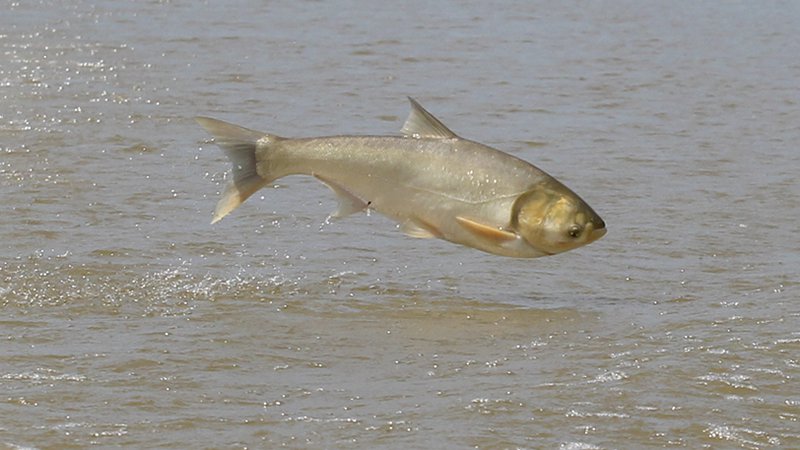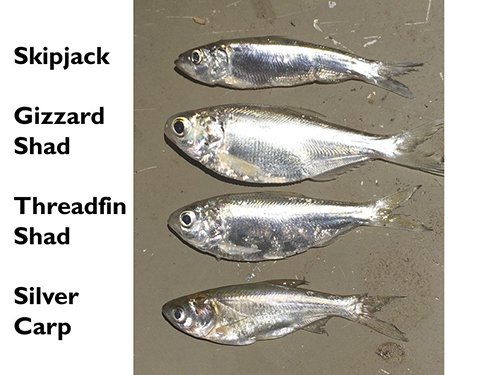Arkansas fighting Asian carp with angler awareness, baitfish regulations
ON 08-08-2018

Aug. 8, 2018
Randy Zellers
Assistant Chief of Communications
LITTLE ROCK – Fish jumping into the boat sounds like a dream come true for some anglers — until you’ve experienced it firsthand. That’s exactly what’s happening on some Arkansas lakes connected to the Mississippi River, and it’s causing a lot of concern.
Asian carp, particularly silver carp and bighead carp, have invaded many of these lakes. Silver ones have a tendency to leap from the water when startled by the sound of passing boats. With adults weighing up to 50 pounds, that can create an extremely dangerous situation for boaters.
Diana Andrews, fisheries supervisor for the Arkansas Game and Fish Commission in Monticello, says the fish were found in Lake Chicot in Chicot County in 2005. By 2007 they had grown large enough to cause an issue with boating and recreation on the lake.
“We have had many reports of near misses and strikes from anglers and pleasure boaters,” Andrews said. “And one boy was struck so badly in 2008 while tubing that the impact knocked him unconscious and broke his jaw.”
The AGFC has opened commercial fishing seasons on Chicot and other lakes to entice commercial anglers to help remove the carp, but the market for these Asian fish is small.
“In addition to the carp, there are good populations of buffalo and catfish that will make good incentives for the commercial anglers to help us with the carp issue,” Andrews said.
Asian carp originally were imported from Southeast Asia in efforts to keep wastewater treatment facility retention ponds clean and to reduce organic matter in some aquaculture facilities. However, flooding and accidental releases from those initial ponds enabled the fish to escape into the Mississippi River system, where they have played havoc on boaters and threatened to enter the Great Lakes.
Jimmy Barnett, aquatic nuisance species coordinator for the Arkansas Game and Fish Commission, says other than their habit of jumping and causing a boating hazard, these carp may also have the ability to overpopulate a system and decimate the base of that fisheries food chain.
“They’re not predators, but they eat plankton, which is what feeds smaller baitfish. That food gets used up by the carp instead of adding to the food chain, and the whole system suffers, including sportfish like bass and crappie,” Barnett said.
The old adage, “An ounce of prevention is worth a pound of cure,” truly applies to aquatic invasive species. Once introduced, they can grow undetected for years. Typically by the time their presence is known, managers face an uphill battle just to slow their spread and minimize their impact.
Some states have tried to eliminate these carp through every means from bowfishing tournaments to high-tech soundwave technology to corral fish. Some techniques have shown limited success in removing a portion of large carp infestations in shallow lakes, but the most effective cure for these invaders is preventing them from getting in the system to begin with.
Many lakes and rivers throughout the U.S. are connected, be it by meandering routes of natural free-flowing streams or man-made canals and lock-and-dam systems for commerce. However, one of the fastest ways for any invasive species to spread is by hitching a ride with boaters or anglers. One likely culprit of some transplants is through what Barnett refers to as “bait bucket stockings.”
“Live bait taken from the wild can carry with it all sorts of issues,” Barnett said. “Not only can the baitfish be harboring a disease or parasite they can spread to a new system, but the fish themselves may not be native.”
Beginning Oct. 1, 2018, no live bait originating from the wild will be allowed to be transported outside of the body of water where it was caught or upstream beyond any dam in that body of water. The new regulation was passed last year, with an extended effective date to ensure any baitfish grower may have time to grow large enough bait to replace those most commonly caught from the wild, and ensure anglers still would have a viable option for the large live bait used for species like striped bass and large catfish.
“Small Asian carp are very similar in appearance to shad and skipjack, and when they’re all dumped into one bait bucket, they can blend in,” Barnett said. “The same goes for anglers catching a bunch of green sunfish for trotlining; they may inadvertently catch a snakehead or two and transplant them without knowing it until it’s too late.”
Seasoned fisheries biologists may be able to tell the difference between some species of common native baitfish and young Asian carp, but even veteran anglers could be confused on the identification of some of these fish, especially in a bait bucket full of fish. All it takes is one net haul of invasives in the bucket to spread these species to new waters.
 Common baitfish alongside silver carp. Photo by Mississippi Department of Wildlife, Fisheries and Parks.
Common baitfish alongside silver carp. Photo by Mississippi Department of Wildlife, Fisheries and Parks.
Barnett says the AGFC is working to define the leading edge of the infestation in Arkansas, to determine exactly where Asian carp have travelled so far.
“We know they’re in the Arkansas, St. Francis, White, Black and Red Rivers, but we want to identify any of the major tributaries that connect to these rivers and if the carp have made it to them,” Barnett said.
Barnett says one way the public can help with the fight in Arkansas is to report whenever they see any invasive species, such as Asian carp, to the AGFC’s aquatic nuisance species program at reportans@agfc.ar.gov.
“If you can get a picture or good description of what you see, please send it in and help us determine just how far some of these species have spread,” Barnett said. “The first step to fixing the problem is to discover just how far it reaches.”
Recent News

Arkansas Wildlife Weekly Fishing Report
Jul. 10, 2025

Lonoke aquaculturist named to AGFC
Jul. 10, 2025
Subscribe to Our Weekly Newsletter E-mails
Don’t miss another issue. Sign up now to receive the AGFC Wildlife Weekly Newsletter in your mailbox every Wednesday afternoon (Waterfowl Reports are published weekly during waterfowl season and periodically outside the season). Fishing Reports arrive on Thursdays. Fill in the following fields and hit submit. Thanks, and welcome!
